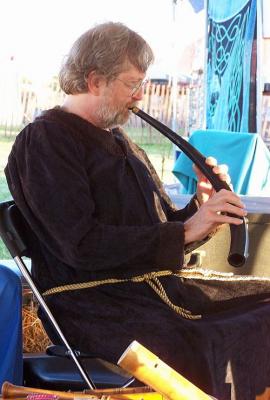Rebec
 click image for rebec sound
click image for rebec sound
(155kb wav)
or here for same in mp3 format
"In twenty manere koude he trippe and daunce
After the scole of Oxenforde tho,
And with his legges casten to and fro,
And pleyen songes on a smal rubible;
Therto he song som tyme a loud quynyble."
-Chaucer, The Miller's Tale
Mutse Clutse
(including a rebec)
Aridan Branle - dance tune
(includes rebec on second verse)
War Branle - dance tune by Arbeau
(includes rebec)
The use of a bow on stringed instruments probably originated in central Asia during the ninth century, spreading through Islamic and Byzantine territories and later reaching western Europe in the tenth to twelfth centuries. Bowing may have developed in an attempt to create an instrument which could imitate the voice. Bowing gave stringed instruments the sustaining power necessary to play a continuous melodic line. Nevertheless, the status of these bowed instruments and their players remained low. The rebec was definitely an instrument of the lower classes, not the court.

The rebec (rebeca, rebecq, rebet, ribeca, rebecum, rabel, or rebequin) came from the Arabian rabob. It has been known in Europe since the 10th century but their use in art music was chiefly during the Middle Ages and Renaissance. The rebec's rounded pear-shaped body is carved from a single block of wood and tapers in such a way that there is no visible distinction between the body and the neck. The fingerboard is a raised part of the soundboard or is fixed to it from above, but this does not change the frontal outline of the instrument. Early rebecs had no soundpost and the pegholder is flat. As with most early instruments, rebecs came in many sizes and pitches and although the number of strings on early rebecs varied from three to five, the three-stringed rebec seems to be the most popular.
 In the Middle Ages the most common rebec was the soprano, played by resting it on one's shoulder, across the chest, or in the armpit. The instrument often has frets, and probably had a thin nasal, penetrating tone, Rebecs are associated with secular intrumental music, especially dance music, and their role in the latter continues to the eighteenth century. Remnants of its tone and style can be heard in the country fiddling of the United States.
In the Middle Ages the most common rebec was the soprano, played by resting it on one's shoulder, across the chest, or in the armpit. The instrument often has frets, and probably had a thin nasal, penetrating tone, Rebecs are associated with secular intrumental music, especially dance music, and their role in the latter continues to the eighteenth century. Remnants of its tone and style can be heard in the country fiddling of the United States.
Musica Antiqua's soprano rebec was built by Hart Workshop.
Additional Resources:
- The Rebec Project
- Minstrels with Rebec and Lute - Image from the Virtual Art Gallery
- S. Virdung: Musica getutscht (Basle, 1511/r1970)
- M. Agricola: Musica instrumentalis deudsch (Wittenberg, 1528/r1969)
- H. Gerle: Musica teusch (Nuremberg, 1532/r1977)
- M. Praetorius: Syntagma musicum (Wolfenbuttel, 1618/r1958)
- H. Panum: Middelalderens strengeinstrumenter (Copenhagen, 1915-31)
- J. Rittmeyer-Iselin: 'Das Rebec: ein Beitrag zur Geschichte unserer Streichinstrumente', Festschrift Karl Nef zum 60. Geburtstag (Zurich and Leipsig, 1933)
- E. van der Straeten: The History of the Violin (London, 1933)
- A. Baines: 'Fifteenth-century Instruments in Tinctoris's De inventione et usu musicae', GSJ, (1950)



 Additional Resources:
Additional Resources:
 Very little breath is used in playing the zink. Mersenne mentions a French court musician, M. Sourin of Avignon, who could play one hundred measures in one breath!!
Very little breath is used in playing the zink. Mersenne mentions a French court musician, M. Sourin of Avignon, who could play one hundred measures in one breath!! Musica Antiqua's collection of small size zinks includes a soprano zink in c1 by Monk, a soprano in c1 and an alto in a by Moeck, and a nicolo in c by Monk. See the
Musica Antiqua's collection of small size zinks includes a soprano zink in c1 by Monk, a soprano in c1 and an alto in a by Moeck, and a nicolo in c by Monk. See the 

 There are few professional touring ensembles specializing in the performance of music and dance of the Middle Ages and Renaissance. None play such a variety of music with as many different instruments as does Musica Antiqua. The ensemble has received Touring Grants from the Iowa Arts Council every year since 1971.
There are few professional touring ensembles specializing in the performance of music and dance of the Middle Ages and Renaissance. None play such a variety of music with as many different instruments as does Musica Antiqua. The ensemble has received Touring Grants from the Iowa Arts Council every year since 1971. 

 Renaissance recorders differ from Baroque recorders in that they have a larger bore which gives a stronger low register, making them better suited for blend and ensemble playing. Recorders from this period generally have smaller range than the Baroque recorders.
Renaissance recorders differ from Baroque recorders in that they have a larger bore which gives a stronger low register, making them better suited for blend and ensemble playing. Recorders from this period generally have smaller range than the Baroque recorders.


